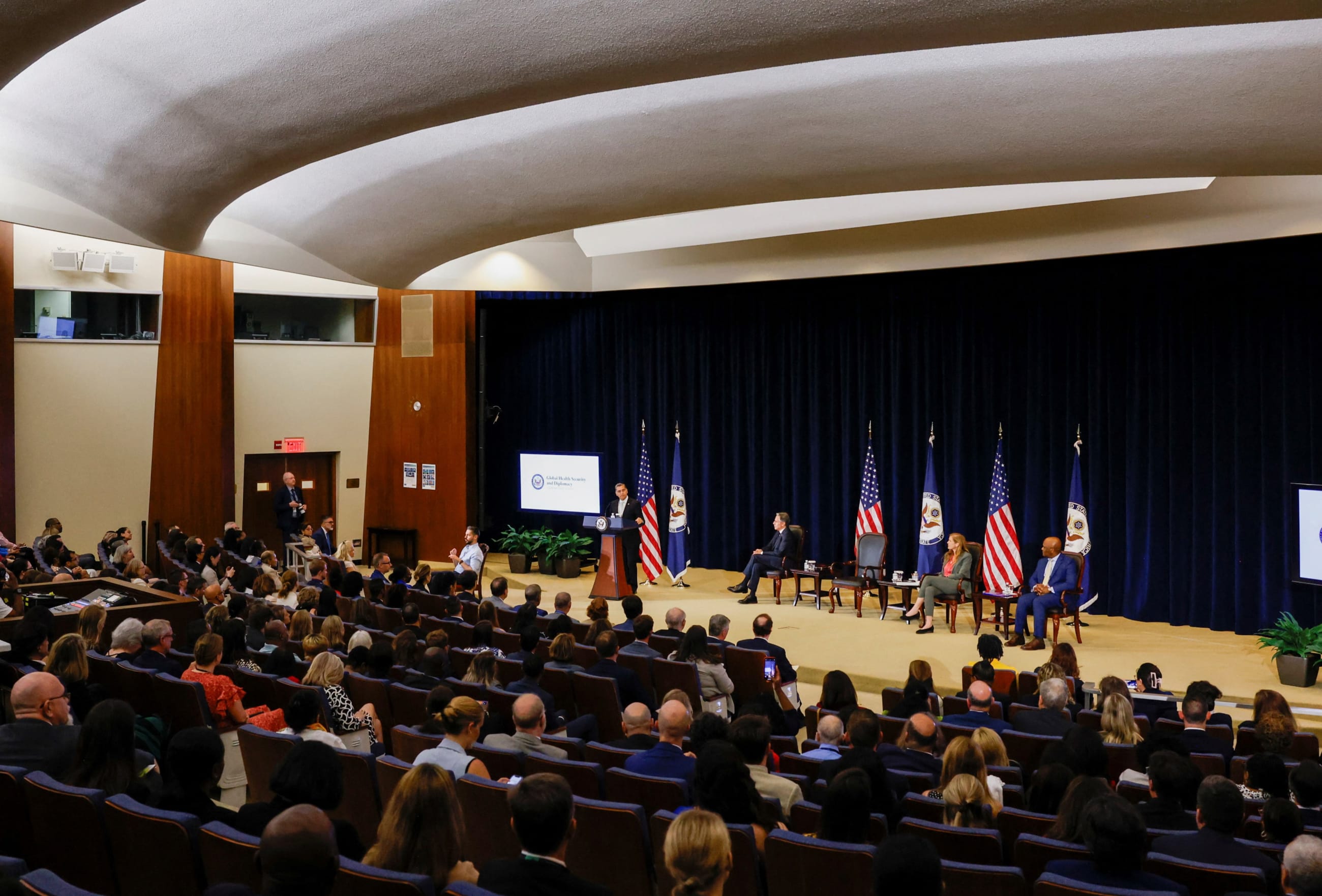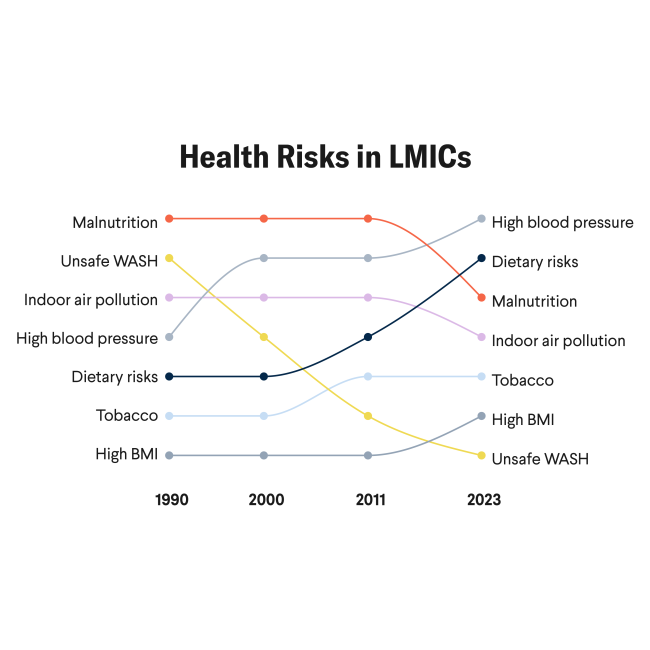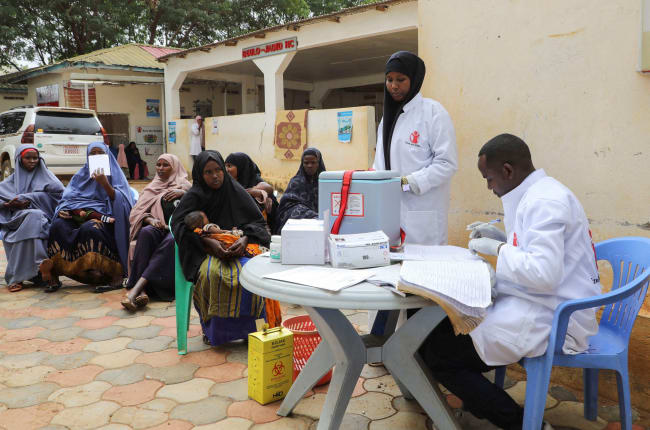In April, the Joe Biden administration released the U.S. Government Global Health Security Strategy 2024. Such documents have been issued before, but the latest strategy is the first to account for the COVID-19 pandemic's impact on the American people, the domestic economy, and U.S. foreign policy interests. It follows other strategic plans the Biden administration developed in response to the pandemic, including the National Biodefense Strategy 2022 and the National Health Security Strategy 2023–2026.
The scale and severity of COVID-19's damage underscore the failure of pre-pandemic U.S. strategies and policies on national and global health security. In foreign policy, U.S. engagement on global health did not protect the U.S. population and economy from the greatest threat to health security—a pandemic. In the words of Stephanie Psaki, inaugural U.S. coordinator for global health security, that failure triggers the "most important question" for the White House about the new strategy: How does it "protect the health and well-being of the American people?"
Whether the strategy achieves that objective remains to be seen. But it can be probed to assess whether its mixture of policy change and continuity transforms U.S. global health engagement in ways that protect the health and well-being of the American people.
Vision and Strategy Statements
The document begins with a vision statement that immediately raises questions: "A world where all people are protected from health security threats, particularly those posed by infectious diseases." That vision is more expansive than protecting American health and well-being, which the White House considers the most important challenge under the strategy.
That lack of preparedness reflected, among other things, inadequate collective action on the pandemic threat
Before COVID-19, the United States spent significantly more political and economic capital on global health programs to protect people in other countries from infectious diseases, such as HIV/AIDS, than it did on pandemic preparedness. The death, disease, and economic dislocation Americans experienced from COVID-19 exposed how little, if at all, such decades-long programs protected health and well-being in the United States when a serious infectious disease threat emerged. The vision statement reflects no awareness of that misalignment in U.S. national interests concerning global health.
The document follows its vision with a strategy statement that commits the United States to work with other countries to combat infectious disease threats and make collective action more "efficient, effective, sustainable, and equitable." The statement echoes declarations made before COVID-19 about the importance of international cooperation that reflected unprecedented levels of collective action on global health in the post–Cold War period.
But collective action crumpled when a pandemic hit because the United States and many other countries were unprepared for the most dangerous infectious diseases. That lack of preparedness reflected, among other things, inadequate collective action on the pandemic threat. Generically acknowledging the need for collective action is not a strategic statement responsive to the policy failures that COVID-19 exposed.
Global Health Security Funding Lags Behind
Before COVID-19, funding to combat infectious diseases far outweighed support for pandemic preparedness in the United States
Foreign Policy Benefits of Global Health Engagement
Before COVID-19, U.S. policymakers frequently justified global health engagement because it supported numerous U.S. foreign policy interests, including democracy promotion and maintaining an international system favorable to the United States. The new strategy makes no such ideological or system claims. That change reflects recognition that democracy declined globally and geopolitics adverse to U.S. interests returned to international relations during the period before COVID-19 when U.S. global health leadership was unrivaled.
The strategy's humbler approach to the foreign policy importance of global health engagement raises questions connected to the problems with its vision and strategy statements. It is not clear what foreign policy advantages the United States gets from seeking a world where all people are protected from health security threats through collective action. Some case, however, should be made if the vision statement is intended to transform foreign policy on global health.
Making that case is not easy. Through the President's Emergency Plan for AIDS Relief (PEPFAR), the United States has spent more than $100 billion in Africa fighting HIV/AIDS, yet finds itself scrambling to compete geopolitically with China and Russia across a continent experiencing a rise in authoritarianism. Despite such unprecedented levels of U.S. global health engagement, African discontent with the United States on development policies, economic relations, health assistance, security issues, and vaccine inequities during COVID-19 runs deep.

Strategic Goals
The new strategy sets three goals to guide U.S. policy on global health security: strengthen global health security capacities through bilateral partnerships; catalyze political commitment, financing, and leadership to achieve health security; and increase linkages between health security and complementary programs to maximize impact.
Those goals reflect the major policy changes that the Biden administration believes are needed to strengthen global health security against dangerous infectious disease events. The strategy directs the U.S. government to help partner countries build global health security capacities; increase political commitment to, and financial resources for, global health security purposes; and recalibrate existing U.S. global health engagements to support global health security—what the strategy calls creating synergies across U.S. global health programs.
The goals reflect acknowledgment that, before COVID-19, U.S. global health policies paid insufficient attention to health security capacity, funding, and connections to other U.S. global health commitments. Under the strategy, the U.S. government should elevate the political, diplomatic, budgetary, and programmatic importance of health security capabilities relevant to protecting the United States from serious infectious disease threats.
The strategy contains more details on each goal, but a few features deserve attention here. The strategy prioritizes bilateral diplomacy for the capacity-building policy pivot, an approach that could concern those who favor multilateralism in global health. As evidenced by PEPFAR, the President's Malaria Initiative (PMI), and USAID's Global Tuberculosis Strategy, the U.S. preference for bilateralism in its global health policies is well established, but that approach has, in practice, been coordinated with regional, multinational, and multistakeholder activities.
As former Senator Richard Burr (R-NC) noted, the strategy aligns with U.S. involvement with 70 other countries in the Global Health Security Agenda (GHSA) and uses public health capacity evaluation-and-monitoring frameworks developed by the World Health Organization to support the International Health Regulations (2005). The strategy also considers the GHSA politically and diplomatically important in "bridging the gap between expert knowledge and decision-making power to help shape global policy."
Similarly, the policy pivot on global health security financing seeks to use existing mechanisms, such as the Pandemic Fund, ongoing diplomatic processes including the Group of Seven (G7) and Group of 20 (G20), and international financial institutions to increase global health security funding. That approach is prudent, even if doubts exist about reaching and sustaining the levels of global health security financing thought necessary.
The U.S. government should elevate the political, diplomatic, budgetary, and programmatic importance of health security capabilities
The pattern of change-with-continuity is also apparent in the goal on creating synergies among U.S. global health endeavors to boost global health security. The strategy embraces the potential to maximize synergies between global health security projects and "complementary health, development, and security programs." Such programs include PEPFAR, PMI, and USAID's Global Tuberculosis Strategy.
Creating synergies across policy areas is easier in theory than in practice. The strategy cautions that better alignment of global health security efforts with other global health programs faces challenges, including specific legislative mandates and funding streams for programs that limit reallocation of those resources to support global health security.
Such constraints on synergies raise the question whether Congress should allocate more money to global health security and less to other global health programs. The strategy points out that funding for global health programs is "imbalanced across sectors." Funding for PEPFAR, for example, dwarfs the resources budgeted for global health security identified by the strategy.
Approaches and Principles
The strategy also prescribes approaches and principles to guide the policy changes needed to achieve the strategic goals. That guidance highlights ideas that have been around for a long time and include using whole-of-government, science-based, One Health, country-ownership, and equity-and-inclusion approaches. Application of those approaches and principles before COVID-19 was often more rhetorical than real. The pandemic has revived interest in them, but operationalizing them remains a daunting challenge, especially because elevating global health security creates even more policy demands, complexities, and friction.
For example, the strategy's delineation of the U.S. departments, agencies, programs, and personnel implicated by a whole-of-government approach highlights a fragmentation problem that calls for more root-and-branch reform of governmental authority over health security. In some ways, government organizational reforms made because of the pandemic have exacerbated the whole-of-government challenge. The strategy, however, does not propose reforms that would make U.S. government action in global health more streamlined, authoritative, and effective.
Health Security and Climate Change
In addition to confronting the COVID-19 disaster, the strategy acknowledges the global threat to health security that climate change poses. The strategy identifies climate change as a health security risk, and it mentions climate programs, including the President's Emergency Plan for Adaptation and Resilience (PREPARE), as opportunities to create synergies with global health security efforts.
Even so, the strategy missed an opportunity to address health security dangers from climate change beyond infectious diseases—such as drought, extreme heat, flooding, and sea-level rises—that do not, like pathogens, cross borders and threaten American health and well-being.
To make matters worse, the United States confronts the same dangers. Those threats will become more frequent and severe at home and abroad. Climate change is a surging, chronic challenge for health security in which adaptation policy synergies that protect both domestic and foreign populations are hard to find.
Elections Matter
Policy strategies take time to have impact. The Biden administration envisions that its new strategy will guide the U.S. government for the next five years. The strategy might, however, have a shelf life of only five months with the U.S. general election taking place in November. Donald Trump's return to the White House would change U.S. foreign policy on global health, including how the U.S. government seeks to protect Americans from infectious disease threats.
The U.S. general election in 2020 took place during the COVID-19 pandemic, and President Trump and candidate Biden offered voters contrasting approaches for managing COVID-19 and preparing for future pandemics. In 2024, the differences between President Biden and candidate Trump on global health security are again stark. Without a clear and present pathogenic danger, whether such differences will matter to most American voters is unlikely.













